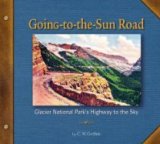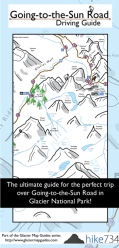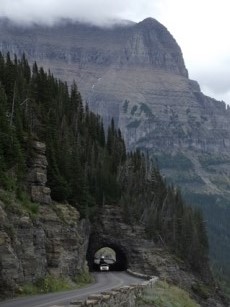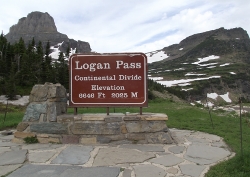


| The Going-to-the-Sun Road |
The only road to cross Glacier National Park from east to west, the epic Going-to-the-Sun Road, carries travelers through some of the most spectacular scenery the park has to offer. This engineering marvel spans more than 50 miles across the park's interior, takes passengers over the Continental Divide at Logan Pass, and treats visitors to some of the grandest sights in the Rocky Mountains. Along its course the road passes glacial lakes and cedar forests in the lower valleys, and windswept alpine meadows and sweeping mountain vistas atop the 6646-foot pass.
Several scenic viewpoints and pullouts along the way provide motorists with ample opportunities to stop for extended views and photographs.
 Some drivers (and passengers) might be a little intimidated by the Going-to-the-Sun Road. Portions of the route hug the mountainside as it traverses over steep drop-offs and steers through tight curves. Due to very little clearance with oncoming traffic, vehicles (and vehicles in combination with trailers) longer than 21 feet (including bumpers) or wider than 8 feet (including mirrors), are prohibited between Avalanche Campground and the Sun Point parking area. Also, due to rock overhangs, vehicles over 10 feet
in height may have difficulty driving west from Logan Pass to The Loop.
Some drivers (and passengers) might be a little intimidated by the Going-to-the-Sun Road. Portions of the route hug the mountainside as it traverses over steep drop-offs and steers through tight curves. Due to very little clearance with oncoming traffic, vehicles (and vehicles in combination with trailers) longer than 21 feet (including bumpers) or wider than 8 feet (including mirrors), are prohibited between Avalanche Campground and the Sun Point parking area. Also, due to rock overhangs, vehicles over 10 feet
in height may have difficulty driving west from Logan Pass to The Loop.
There are two tunnels, one on either side of Logan Pass, that motorists will drive through. The East Side Tunnel is 408 feet long, while the West Side Tunnel is 192 feet in length.
The best thing to do is to follow the speed limit, drive carefully, and enjoy the majestic scenery the road has to offer.
Generally speaking, the Going-to-the Sun Road is usually open from early June thru mid-October. Snow makes the road impassable in the winter. With up to 80 feet of piling atop Logan Pass, Going-to-the-Sun is one of the most difficult roads in North America to plow in the spring.
In 1932, after three decades of construction, almost 500,000 pounds of explosives, and more than $2,000,000 in costs, the first automobile drove the entire length of the Going-to-the-Sun Road. Glacier National Park formally opened the road in a special ceremony at Logan Pass on July 15, 1933. During the dedication, Governor Frank H. Cooney stated that "There is no highway which will give the seer, the lover of grandeur of the Creator's handiwork, more thrills, more genuine satisfaction deep in his being, than will a trip over this road."
 The road received its name during the 1933 dedication, borrowing it from nearby Going-to-the-Sun Mountain. Local legend, as relayed in a 1933 Department of the Interior press release, tells the story of the Blackfoot deity, Sour Spirit, who came down from the sun to teach young braves the basics of hunting. On his way back to the sun Sour Spirit had his image reproduced on the top of the mountain for inspiration to the Blackfeet. An alternate story, however, suggests that a white explorer in the 1880s concocted the name and the legend.
The road received its name during the 1933 dedication, borrowing it from nearby Going-to-the-Sun Mountain. Local legend, as relayed in a 1933 Department of the Interior press release, tells the story of the Blackfoot deity, Sour Spirit, who came down from the sun to teach young braves the basics of hunting. On his way back to the sun Sour Spirit had his image reproduced on the top of the mountain for inspiration to the Blackfeet. An alternate story, however, suggests that a white explorer in the 1880s concocted the name and the legend.
In 1983 the Going-To-The-Sun Road was added to the National Register of Historic Places, and in 1985 was made a National Historic Civil Engineering Landmark.
Let the National Park do the Driving
Visitors can now access many of the destinations along the Going-to-the-Sun Road by riding on one of the park's optional shuttle buses. The shuttle system was established to offer options to visitors wishing to avoid traffic and parking problems during the rehabilitation of the Going-to-the-Sun Road.
The transit system provides two-way service along the road between the Apgar Transit Center and the St. Mary Visitor Center. Shuttles run every 15 to 60 minutes (depending on location and time of day) from 7:00 a.m. and 7:00 p.m. There's no charge, and no tickets are required to ride the shuttle. Transit stops are clearly marked along the route.
Current bus schedules are posted at each shuttle stop, at informational kiosks available inside visitor centers and transit centers, and on the Park website.
Click here for more information on the shuttle stops.
Click here for the current road status.
Click here for information on cycling the Going-to-the-Sun Road.
The following is a quick reference guide for the Going-to-the-Sun Road:
| Location | Mileage from: | Description | Shuttle Stop | ||
| West Glacier | St. Mary | Trails | |||
| West Glacier | 0.0 | 50.1 | All services available in town. | ||
| Apgar Village | 2.6 | 47.5 | Food, lodging, stores, gift shops & visitor center. | McDonald Creek Bike Path | |
| Apgar Transit Center | 2.6 | 47.5 | West side hub free shuttle bus system. | Yes | |
| Apgar Campground | 2.6 | 47.5 | Largest campground in the park. Picnic Area | ||
| Sprague Creek Campground | 9.0 | 41.1 | Popular campground for tents. Adjacent to Lake McDonald. Picnic area. | Yes | |
| Lake McDonald Lodge | 10.8 | 39.3 | Boat tours, horseback rides, food, and all services available. | Yes | Fish Lake, Mt. Brown Lookout, Snyder Lake, Sperry Chalet |
| McDonald Creek Overlook / Johns Lake | 12.8 | 37.3 | Johns Lake Loop | ||
| Avalanche Creek / Trail of the Cedars | 16.2 | 33.9 | Avalanche Creek campground and picnic area. Very popular area, parking can be difficult. | Yes | Avalanche Lake, Trail of the Cedars |
| West Tunnel | 24.0 | 26.1 | The 192 foot tunnel was bored through the mountain in 1926. | ||
| The Loop | 24.6 | 25.5 | The only switchback
on the Going-to-the -Sun Road. Scenic views of Heaven's Peak. |
Yes | Granite Park Chalet |
| Bird Woman Falls Overlook | 26.8 | 23.3 | Bird Woman Falls cascades 492 feet down the slopes of Mt. Oberlin across the valley. | ||
| Weeping Wall | 28.7 | 21.4 | The long length of wall features a gushing waterfall in the spring, which reduces to a mere trickle in late summer and fall. | ||
| Big Bend | 29.0 | 21.1 | One of road's most spectacular vista points: views of Mt. Canon, Mt. Oberlin, Heaven's Peak, and the Weeping Wall. | ||
| Triple Arches | 30.5 | 19.6 | Architectural and engineering marvels best seen by eastbound travelers. | ||
| Oberlin Bend | 31.7 | 18.4 | Spectacular views, Oberlin Falls. Good place to see mountain goats. | ||
| Logan Pass | 32.0 | 18.1 | Logan Pass sits on the Continental Divide at 6,646 feet. Visitor Center parking fills early. | Yes | Highline Trail, Hidden Lake Overlook |
| Lunch Creek | 32.6 | 17.5 | Lots of wildflowers in the summer. Lunch Creek flows down a natural rock staircase with Pollack Mtn in background. | ||
| East Tunnel | 33.0 | 17.1 | The 408-foot tunnel passes thru Piegan Mountain. | ||
| Siyeh Bend | 34.2 | 15.9 | Trailhead for a couple of outstanding hikes. | Yes | Piegan Pass, Siyeh Pass, Preston Park |
| Jackson Glacier Overlook | 36.1 | 14.0 | The best view of a glacier from anywhere on the Going-to-the-Sun Road. | ||
| Gunsight Pass Trailhead | 36.3 | 13.8 | Trailhead for a couple of outstanding hikes. | Yes | Deadwood Falls, Florence Falls, Gunsight Lake |
| St. Mary Falls Shuttle Stop | 38.6 | 11.5 | Trailhead for a couple of outstanding hikes. | Yes | St. Mary Falls, Virginia Falls |
| Sunrift Gorge | 39.4 | 10.7 | A short 75 foot walk to a spectacular view of a water-carved gorge. | Yes | Baring Falls, Siyeh Pass |
| Sun Point | 40.0 | 10.1 | Picnic Area. Awesome views of St. Mary Lake. | Yes | Sun Point Nature Trail |
| Wild Goose Island | 42.5 | 7.6 | One of the most frequently photographed spots in the park. | ||
| Golden Staircase | 42.8 | 7.3 | Views of St. Mary Lake. | ||
| Rising Sun | 43.8 | 6.3 | Guided boat tours, campground, lodging, food and services available. Picnic Area | Yes | Otokomi Lake |
| Two Dog Flats | 48.0 | 2.1 | Native grassland community provides habitat for a number of species, such as elk. | ||
| St. Mary Campground | 48.8 | 1.3 | Largest campground on the east side of Glacier National Park. | ||
| St. Mary Visitor Center | 49.3 | 0.8 | Exhibits, publications, and park information. | Yes | Beaver Pond Loop (across from visitor center) |
| St. Mary | 50.1 | 0.0 | Food and all services available in town. | ||